
Aerodynamics is the study of the motion of air, particularly when affected by a solid object, such as an airplane wing. It involves topics covered in the field of fluid dynamics and its subfield of gas dynamics, and is an important domain of study in aeronautics. The term aerodynamics is often used synonymously with gas dynamics, the difference being that "gas dynamics" applies to the study of the motion of all gases, and is not limited to air. The formal study of aerodynamics began in the modern sense in the eighteenth century, although observations of fundamental concepts such as aerodynamic drag were recorded much earlier. Most of the early efforts in aerodynamics were directed toward achieving heavier-than-air flight, which was first demonstrated by Otto Lilienthal in 1891. Since then, the use of aerodynamics through mathematical analysis, empirical approximations, wind tunnel experimentation, and computer simulations has formed a rational basis for the development of heavier-than-air flight and a number of other technologies. Recent work in aerodynamics has focused on issues related to compressible flow, turbulence, and boundary layers and has become increasingly computational in nature.

The Whitcomb area rule, named after NACA engineer Richard Whitcomb and also called the transonic area rule, is a design procedure used to reduce an aircraft's drag at transonic speeds which occur between about Mach 0.75 and 1.2. For supersonic speeds a different procedure called the supersonic area rule, developed by NACA aerodynamicist Robert Jones, is used.

Transonic flow is air flowing around an object at a speed that generates regions of both subsonic and supersonic airflow around that object. The exact range of speeds depends on the object's critical Mach number, but transonic flow is seen at flight speeds close to the speed of sound, typically between Mach 0.8 and 1.2.

The Royal Aircraft Establishment (RAE) was a British research establishment, known by several different names during its history, that eventually came under the aegis of the UK Ministry of Defence (MoD), before finally losing its identity in mergers with other institutions.

Richard Travis Whitcomb was an American aeronautical engineer who was noted for his contributions to the science of aerodynamics.
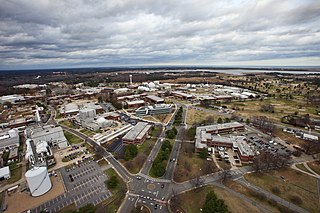
The Langley Research Center, located in Hampton, Virginia near the Chesapeake Bay front of Langley Air Force Base, is the oldest of NASA's field centers. LaRC has focused primarily on aeronautical research but has also tested space hardware such as the Apollo Lunar Module. In addition, many of the earliest high-profile space missions were planned and designed on-site. Langley was also considered a potential site for NASA's Manned Spacecraft Center prior to the eventual selection of Houston, Texas.

The Office national d'études et de recherches aérospatiales (ONERA) is the French national aerospace research centre. It is a public establishment with industrial and commercial operations, and carries out application-oriented research to support enhanced innovation and competitiveness in the aerospace and defense sectors.

The Douglas D-558-2 Skyrocket is a rocket and jet-powered research supersonic aircraft built by the Douglas Aircraft Company for the United States Navy. On 20 November 1953, shortly before the 50th anniversary of powered flight, Scott Crossfield piloted the Skyrocket to Mach 2, or more than 1,290 mph (2076 km/h), the first time an aircraft had exceeded twice the speed of sound.
The von Karman Institute for Fluid Dynamics (VKI) is a non-profit educational and scientific organization which specializes in three specific fields: aeronautics and aerospace, environment and applied fluid dynamics, turbomachinery and propulsion. Founded in 1956, it is located in Sint-Genesius-Rode, Belgium.

Robert T. Jones,, was an aerodynamicist and aeronautical engineer for NACA and later NASA. He was known at NASA as "one of the premier aeronautical engineers of the twentieth century".
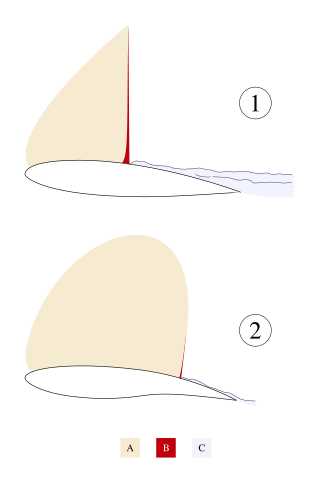
A supercritical aerofoil is an airfoil designed primarily to delay the onset of wave drag in the transonic speed range.
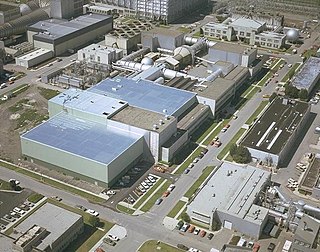
The Unitary Plan Wind Tunnel, located at the NASA Ames Research Center in Moffett Federal Airfield, Mountain View, California, United States, is a research facility used extensively to design and test new generations of aircraft, both commercial and military, as well as NASA space vehicles, including the Space Shuttle. The facility was completed in 1955 and is one of five facilities created after the 1949 Unitary Plan Act supporting aeronautics research.
The University of Texas at Arlington Aerodynamics Research Center (ARC) is a facility located in the southeast portion of the campus operated under the Department of Mechanical and Aerospace Engineering. It was established in 1986 as part of an expansion of UTA's College of Engineering. The ARC contributes to the vision of UTA and the University of Texas System to transform the university into a full-fledged research institution. It showcases the aerodynamics research activities at UTA and, in its history, has established itself as a unique facility at a university level. The wind tunnels and equipment in the facility were mainly built by scouting for and upgrading decommissioned equipment from the government and industry. Currently, Masters and Ph.D. students perform research in the fields of high-speed gas dynamics, propulsion, and Computational fluid dynamics among other projects related to aerodynamics.
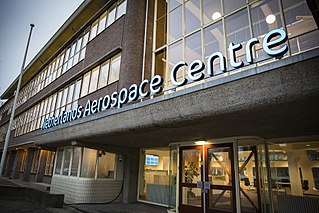
The Royal Netherlands Aerospace Centre, formerly known as the National Aerospace Laboratory is an aerospace research organization of the Netherlands and is one of its major technological institutes. These institutes perform a large part of the applied research in the Netherlands, each within its own specific field of technology. As an independent non-profit organization, the NLR is the aerospace-knowledge enterprise in the Netherlands and provides technical support to the aerospace sector.

The Eight-Foot High Speed Tunnel, also known as Eight-Foot Transonic Tunnel, was a wind tunnel located in Building 641 of NASA's Langley Research Center in Hampton, Virginia. It was a National Historic Landmark.
The Aeronautical/Astronautical Research Laboratory (AARL) is an aerospace engineering research facility operated by Ohio State University. It is the principal research facility of the College of Engineering's Department of Aerospace and Astronautical Engineering. It is located on the grounds of Ohio State University Airport, in Columbus, Ohio.
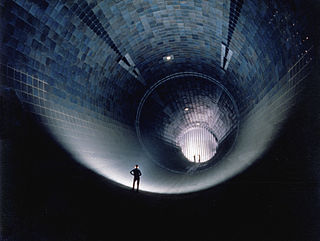
The Propulsion Wind Tunnel Facility, located at Arnold Engineering Development Complex, Arnold Air Force Base, Tennessee, holds three wind tunnels: the 16-foot transonic (16T), 16-foot supersonic (16S), and the aerodynamic 4-foot transonic (4T) tunnels. The facility is devoted to aerodynamic and propulsion integration testing of large-scale aircraft models. The tunnels are powered by a large compressor plant which allows the wind tunnels to run for extended periods of time. The test unit is owned by the United States Air Force and operated by Aerospace Testing Alliance.

The Aerion AS2 was a proposed supersonic business jet that was being developed by Aerion Corporation. In May 2014, it was announced that the Aerion AS2 would be part of a larger Aerion SBJ redesign, which aimed for release after a seven-year developmental period. Aerion partnered with Airbus in September the same year. In December 2017, Airbus was replaced by Lockheed Martin. Its General Electric Affinity engine was unveiled in October 2018. In February 2019, Boeing replaced Lockheed Martin. Development stopped when Aerion ceased operations in May 2021.

Johanna Weber was a German-born British mathematician and aerodynamicist. She is best known for her contributions to the development of the Handley Page Victor bomber and the Concorde.

Mary Jackson was an American mathematician and aerospace engineer at the National Advisory Committee for Aeronautics (NACA), which in 1958 was succeeded by the National Aeronautics and Space Administration (NASA). She worked at Langley Research Center in Hampton, Virginia, for most of her career. She started as a computer at the segregated West Area Computing division in 1951. In 1958, after taking engineering classes, she became NASA's first black female engineer.

















